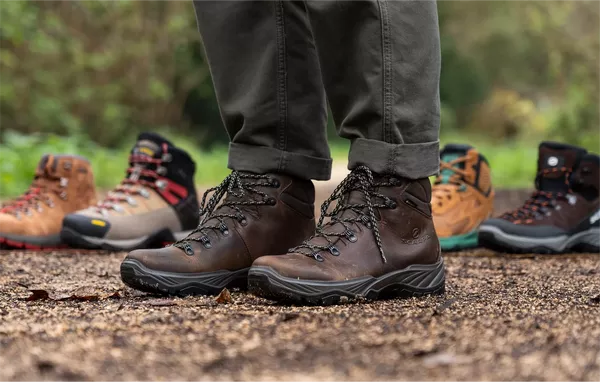Hiking boots are essential gear for any outdoor enthusiast, providing comfort, support, and protection on rugged terrain. Among the myriad of features and specifications that define hiking boots, one abbreviation stands out: GTX. To the uninitiated, this cryptic combination of letters might seem perplexing, but understanding its meaning is crucial for selecting the right footwear for your adventures. In this article, we delve into the depths of hiking boot terminology to decipher the significance of GTX.
Understanding the Terminology
Before unraveling the mystery of GTX, it’s important to grasp some fundamental terminology associated with hiking boots. Hiking boots come in various designs, each tailored to specific types of terrain and activities. These designs are categorized based on their intended use:
- Trail Shoes: Lightweight and flexible, ideal for well-maintained trails and day hikes.
- Hiking Boots: Offering more ankle support and durability, suitable for moderate to rugged terrain.
- Backpacking Boots: Sturdy and supportive, designed for carrying heavy loads over extended treks.
- Mountaineering Boots: Heavy-duty boots built for tackling technical terrain and extreme conditions.
Within each category, you’ll encounter a range of features, including materials, construction techniques, and technologies. One such technology is GTX, which plays a significant role in the performance of hiking boots, especially in adverse weather conditions.
Decoding GTX: Gore-Tex Technology
GTX stands for Gore-Tex, a revolutionary waterproof and breathable membrane technology developed by W. L. Gore & Associates. Since its introduction in 1978, Gore-Tex has become synonymous with high-performance outdoor apparel and footwear. But what sets Gore-Tex apart, and how does it enhance the functionality of hiking boots?
At its core, Gore-Tex is a microporous membrane made from expanded polytetrafluoroethylene (ePTFE), a material renowned for its exceptional waterproofing properties. This membrane contains billions of microscopic pores that are smaller than a water droplet but larger than a water vapor molecule. This unique structure allows Gore-Tex to repel liquid water from the outside while allowing perspiration vapor to escape from the inside, keeping your feet dry and comfortable in wet conditions.
In the context of hiking boots, Gore-Tex technology is integrated into the boot’s construction to create a waterproof barrier that prevents water from penetrating while still allowing moisture to evaporate. This means you can confidently traverse streams, navigate muddy trails, and endure rainfall without worrying about soggy socks or blisters.
Advantages of GTX Hiking Boots
Investing in GTX hiking boots offers a multitude of benefits that enhance your outdoor experience:
1. Waterproof Protection: The primary advantage of GTX technology is its ability to keep your feet dry in wet conditions. Whether you’re crossing a stream or hiking through rain-soaked terrain, GTX boots provide reliable waterproofing to keep moisture at bay.
2. Breathable Comfort: While keeping water out, GTX membranes also allow moisture vapor to escape, preventing heat and sweat buildup inside the boot. This breathability is crucial for maintaining comfort during strenuous hikes and preventing fungal infections or blisters caused by prolonged exposure to moisture.
3. Versatile Performance: GTX hiking boots excel in a wide range of environments, from humid forests to snowy mountainsides. Their all-weather performance makes them suitable for year-round use, allowing you to tackle diverse terrain without compromising on comfort or protection.
4. Durable Construction: Gore-Tex membranes are engineered to withstand the rigors of outdoor adventures, maintaining their waterproofing and breathability even after prolonged use. This durability ensures that your GTX hiking boots will remain reliable companions for countless miles on the trail.
5. Enhanced Traction: Many GTX hiking boots feature advanced outsole designs with aggressive tread patterns that provide superior grip on varied surfaces. Whether traversing rocky slopes or slippery mud, you can trust your GTX boots to keep you stable and secure.
Considerations When Choosing GTX Hiking Boots
While GTX technology offers numerous advantages, there are some considerations to keep in mind when selecting hiking boots:
1. Fit and Comfort: Regardless of the technology used, proper fit and comfort are paramount when choosing hiking boots. Ensure that the boots provide adequate support, cushioning, and room for your toes while maintaining a snug fit to prevent blisters and discomfort.
2. Weight and Flexibility: GTX hiking boots tend to be slightly heavier than non-waterproof counterparts due to the additional membrane layer. Consider the trade-off between waterproofing and weight, especially if you prioritize speed and agility on the trail.
3. Breathability vs. Insulation: While GTX membranes offer breathability, they may not provide the same level of insulation as non-breathable materials. If you anticipate hiking in cold or snowy conditions, consider pairing GTX boots with appropriate socks and insulating layers to keep your feet warm.
4. Maintenance and Care: To ensure long-term performance, proper maintenance of GTX hiking boots is essential. Regular cleaning and application of waterproofing treatments will help prolong the life of the boots and maintain their waterproofing capabilities.
Conclusion
In the world of hiking boots, GTX stands as a symbol of waterproofing excellence and reliable performance. By harnessing the power of Gore-Tex technology, GTX hiking boots offer unparalleled protection, breathability, and versatility for outdoor enthusiasts of all levels. Whether you’re embarking on a day hike or a multi-day trek, investing in GTX boots ensures that your feet stay dry, comfortable, and ready for adventure, no matter what the trail throws your way.


